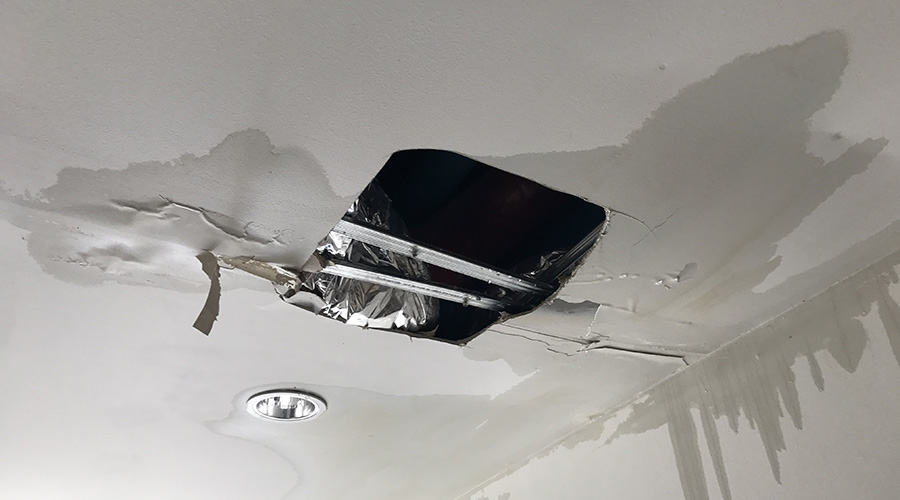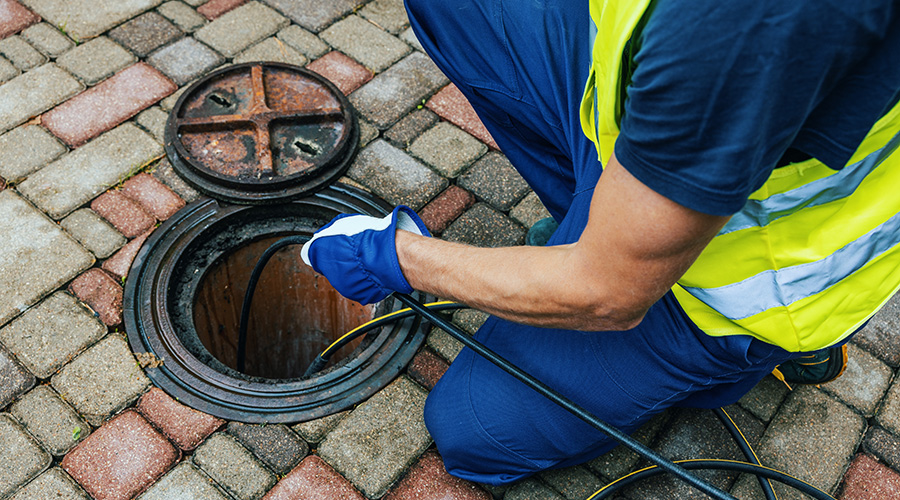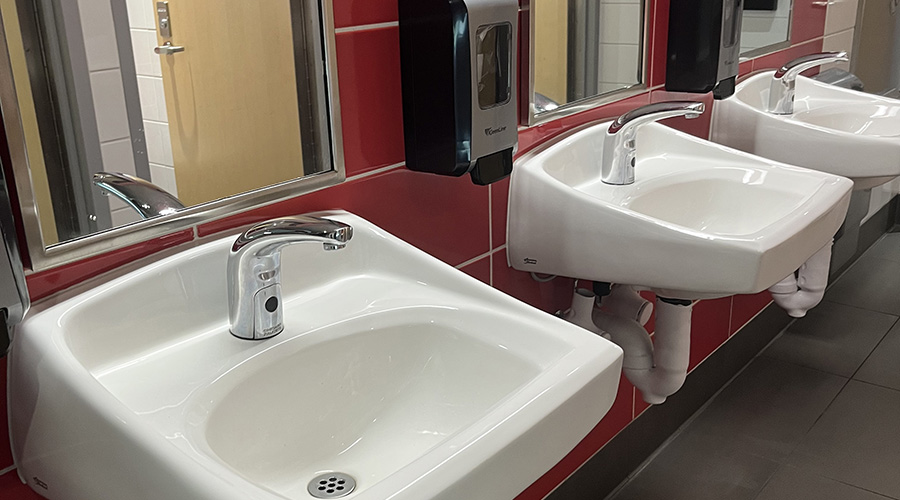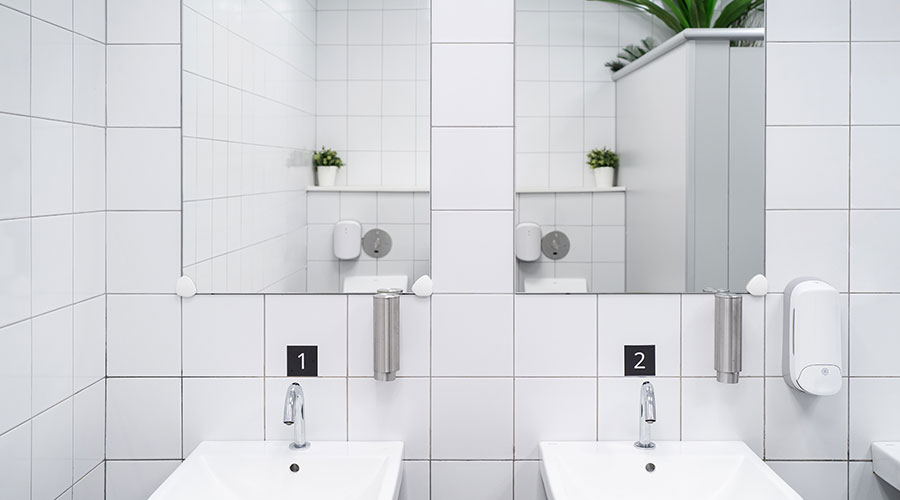Keeping Plumbing Upgrades Flowing
Avoiding common mistakes ensures that projects help facilities meet bottom-line goals
Plumbing system upgrades are among the most popular options for institutional and commercial facilities seeking to control water use, as well as to enhance access and minimize both maintenance time and costs.
Successful plumbing system upgrades, however, require maintenance and engineering managers to consider a range of issues, not the least of which is the point at which a plumbing upgrade is the best option for a facility. Ultimately, the project’s success can depend on identifying the most common mistakes that befall plumbing upgrade projects and taking steps to avoid these pitfalls.
The Upgrade Option
A plumbing upgrade generally is a manager’s best option when the project’s goal is to improve visitor satisfaction, avoid emergencies, comply with regulatory changes, generate savings or improve a facility’s function.
Visitor satisfaction is extremely important because it is an indicator of how well a maintenance department is doing its job. Satisfaction with facility conditions has a major impact on morale, safety and health.
Certainly, managers want to get the upgrade done before the needed work results in an emergency situation for the facility. Any time an emergency occurs, very unhappy restroom visitors are a result. Also, safety and health issues can arise if sewers back up or if toilets overflow or leak waste water, causing dampness where bacteria can form.
Remodeling often is required to meet regulatory guidelines, such as the Americans With Disabilities Act, Occupational Safety and Health Administration, the U.S. Environmental Protection Agency, and local building codes, which establish minimum requirements for buildings.
Projects to ensure compliance with these requirements might not constitute an emergency, but they do have definite deadlines. They cannot be deferred indefinitely, so they must be addressed with a sense of urgency.
Certainly just as important as the first three reasons that justify a plumbing upgrade is good management. Maintenance and engineering managers are always on the lookout for ways to improve functionality and lower costs, and they cannot overlook plumbing upgrades as effective means to achieving that goal.
Managers need to be constantly vigilant in looking for opportunities — and getting them in the budget — so their facilities continue to meet the needs of visitors while holding the line on costs.
Common Mistakes
Plumbing upgrade projects often are complex, and some type of complications seem certain to arise. Among the most common mistakes that facilities make are these:
- Deferring the upgrade until it is an emergency. Often, in the haste to get a problem resolved, managers turn to a temporary solution. But this approach almost always creates more maintenance requirements, higher costs, and more disruption for occupants and visitors.
- Letting deferred regulatory upgrades accumulate until they become unmanageable. With tight budgets more the rule than the exception these days, it will become increasingly harder to catch up with the growing backlog later.
- Considering only the first-cost of the project and materials while ignoring post-installation operating costs. The lowest-cost components used in plumbing upgrades also tend to be those that wear out or fail soonest. Using low-cost materials is a short-term solution that generally ends up costing an organization more in the long run.
- Using add-ons that exceed system capacity. If the goal of remodeling is to add restroom capacity, managers must avoid overloading a facility’s water and sewer system, which might have deteriorated or might not have been designed for added capacity.
- Letting inventories of key spare parts become depleted from inventory. The advantage of planning ahead for plumbing upgrades is workers have all the material available to them when needed. If a repair arises from an emergency, there is a good chance that replacements are not available when needed, delaying the repair.
- Not managing performance so that more actual hours are required to get every job done.
Avoiding Pitfalls
The most common problems related to plumbing system upgrades run the gamut from planning and specification to installation and maintenance. Here are a few of the potentially most costly mistakes.
Planning. Plumbing systems must meet organization objectives related to both function and cost. If either of these objectives is not met, managers can find room for improvement.
Functional effectiveness means satisfied users. Functional objectives relate proper volumes and pressures at the point of use, efficient waste removal from the point of use, and cleanliness. Cleanliness is essential to meeting the functional objectives of high user satisfaction, good health and safe conditions for visitors.
On the other hand, managers also are concerned with cost of added custodians or plumbers to do the work. Managers should focus on upgrades in cleanliness, function and cost together. Improved cleanliness is likely to address much of the overall dissatisfaction, and the restroom will do a much better job of fulfilling its function, while protecting the safety and health of users.
If an upgrade also addresses cost considerations, management will be able to fund the improvements with savings achieved. Cost-effective restroom cleanliness is a product of specifying and installing the most effective and efficient materials and maintaining them properly for optimum performance and regulatory compliance.
Product specification. Constant surveillance is necessary to avoid emergencies and especially to take advantage of product and technology innovations. To paraphrase Henry Ford: “If you need an upgrade and do not obtain it, you will find that you have paid for it without having the use of it.”
In planning for upgrades, managers should consider innovations, quality design and materials, sufficient skilled labor, up-to-date equipment and tools in good condition, and proper maintenance frequency.
Wall and floor surfaces should incorporate low-maintenance tile, epoxy or polyurethane mastic. While these materials are expensive initially, they also are easier to maintain and longer lasting.
Fixtures should be high-quality and modern design. Low-water-use toilets with battery-operated, automatic flush valves and waterless urinals can reduce water and sewer costs, and they enhance functionality and improve user safety and health.
In some situations, installing innovations such water-saving fixtures might not be a luxury. Water conservation might be a necessity, due to the declining availability of water, limited capacity of sewer and septic systems, and rising costs and budget cuts. It is estimated that 22 waterless urinals can save 1 million gallons of water per year.
Sink features should include low-water-consumption valves or low-flow aerators and no-hands, automatic, battery-operated cold- and hot-water valves with vandal-proof features.
These features include protection such as caps and covers that are durable and require special tools to remove. They should eliminate tampering by making it too difficult or time-consuming, increasing the risk of detection.
Hot water can account for 15 percent of the energy bill, so managers should consider addressing this area during an upgrade to existing facilities, which also can save money at the same time. Some hot-water system temperatures are set higher than needed and can be lowered with no noticeable difference to users.
Maintenance. As each new round of regulations take effect, managers should implement a maintenance program that aims to keep the finished plumbing upgrade in top shape. Measuring the work and knowing the impact on the annual maintenance hours is the best assurance that the proper resources are available.
When departments perform reactive instead of proactive maintenance, it eventually will result an emergency situation. This approach also means that workers must defer other work to react to the emergency, thereby creating a backlog of maintenance.
Cleaning. Cleanliness represent 30-40 percent of all visitor complaints. If cleanliness becomes a problem before a project even starts, dissatisfaction among both building occupants and visitors can be very difficult to resolve.
Daily custodial care of the restroom and equipment is essential for optimum post-installation performance. Each day, housekeeping crews should follow a planned routine to ensure that all toilets, sinks, flush valves, dispensers, mirrors, light fixtures, stalls, walls and floors are spotless.
They also should ensure that:
- all low batteries and burned-out lights are replaced
- all waste containers are emptied before they are full — to prevent extra waste pickup from the floor — and cleaned
- all of the paper and soap dispensers are full.
Daily follow-up inspections by custodial supervisors can ensure that thorough, quality cleaning work is being done, and that vandalism is repaired immediately to discourage it. Supervisors also must observe custodians at work, checking that methods are correct and that cleaning solutions are in the proper concentration. On-the-job training instills good work habits, and on-the-job praise improves morale, instills pride and motivates workers to continue the good work.
Most important of all, supervisors need to use weekly performance reports to ensure that proper staffing, methods and equipment are used; that resources are used productively; and that both function and cost objectives are met.
Costly Leaks
Quantifying the savings a plumbing upgrade could generate is essential for approval. Consider this method:
- Read and record the water-meter reading for each area at a time when there is no water use.
- Wait two hours, then go back and again read and record the meter readings.
- Multiply the difference by 4,380 (8,670 hours in a year, divided by two for the two-hour sample).
- Multiply the result by the water and sewer rate to figure cost due to leaks.
For example:
- The gallons lost in two hours equals 40 gallons — the total of all meters
- The gallons lost per year equals 40 multiplied by 4,380, or 175,200 gallons
- The cost of leaks equals 175.2 (yearly leakage in thousands of gallons) multiplied by $6.50 per 1,000 gallons, (the combined sewer and water rate) equals $1,139 lost annually.
By eliminating this loss, managers could offset $1,139 of the upgrade cost by simply stopping leaks. Add to that figure the 1 million gallons saved with, for example, 22 waterless urinals in a university (1 million/1,000 x 6.5 = $6,500), and the result is more than $7,600 that managers could spend on an upgrade without adding to the budget.
|
Resources
In addition to the resources listed below, managers should check local plumbing codes, which take precedence when they differ with other codes or regulations.
- American Society for Testing Materials (ASTM), 1916 Race St., Philadelphia, PA 19103
- American Society of Plumbing Engineers, 3617 Thousand Oaks Blvd., Suite 210, Westlake Village, CA 91362-3649, (805) 495-7120
- American Society of Sanitary Engineers, 28901 Clemens Road, Suite 100, Westlake, OH 44145, (216) 835-3040;
- Americans with Disabilities Act, Checklist for Readily Achievable Barrier Removal for Existing Facilities, available from the Access Board, (800) 949-4ADA
- International Association of Plumbing and Mechanical Officials, 20001 Walnut Drive, South Walnut, CA 91789-8449
- Underwriter’s Laboratories (UL), 333 Pfingsten Road, Northbrook, IL 60062
- Westerkamp, Thomas A., Maintenance Manager's Standard Manual, 2nd edition, Prentice Hall, 1997.
|
Related Topics:











